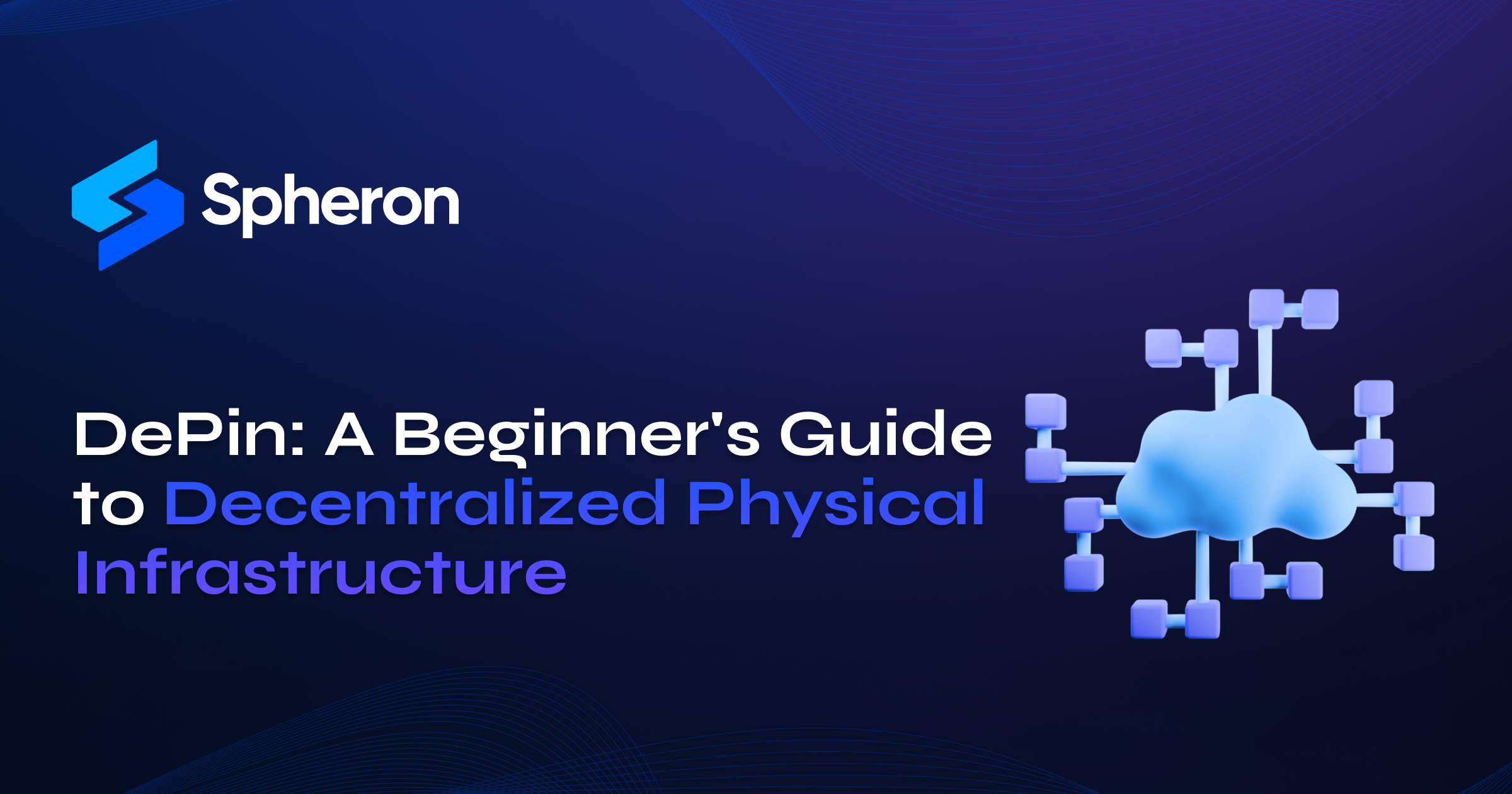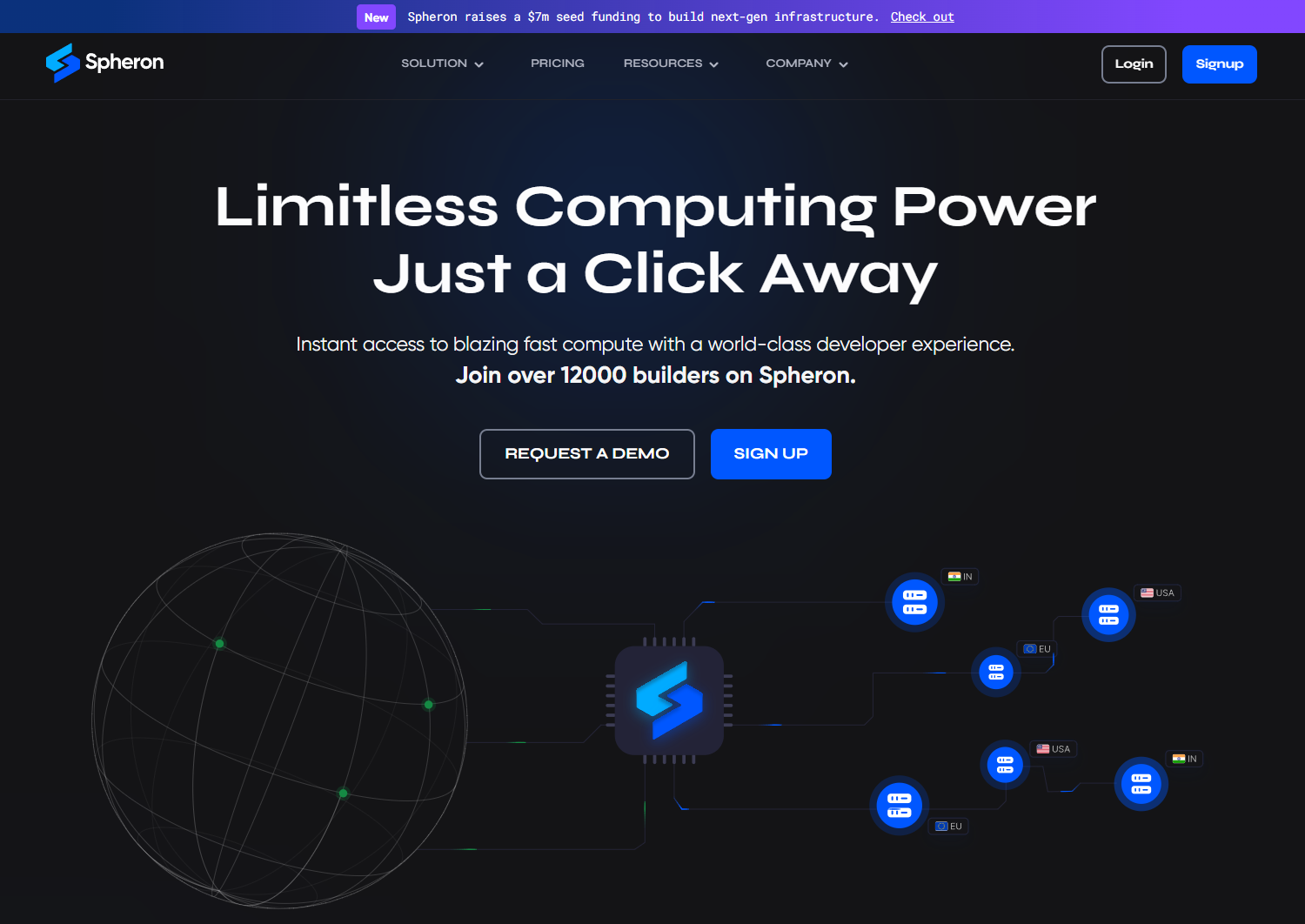DePin: A Beginner's Guide to Decentralized Physical Infrastructure
 Spheron Network
Spheron Network
Decentralized Physical Infrastructure Networks (DePIN) challenges traditional infrastructure models by decentralizing the development and maintenance of physical infrastructure. This paradigm shift is not just theoretical; it’s a practical reimagining of how we build and interact with the physical components of technology.
DePIN represent an innovative convergence of blockchain technology with physical infrastructure. It is a framework where the development, operation, and maintenance of physical infrastructure — such as servers, sensors, and connectivity devices — are distributed among a network of individual contributors instead of being centrally managed. This decentralized approach is facilitated and incentivized through blockchain technology, leveraging token economics to motivate participation and ensure secure, transparent operations.
The components of DePIN
DePIN consist mainly of four components:
1. Physical Infrastructure
The physical infrastructure encompasses tangible elements such as servers, sensors, and connectivity hardware, essential for establishing the network's physical presence and functionalities.
2. Offchain Compute Infrastructure
Offchain compute infrastructure refers to the middleware responsible for processing real-world data before its integration into the blockchain network. It plays a vital role in managing and interpreting data collected by the physical infrastructure.
3. Blockchain Architecture
Blockchain technology forms the cornerstone of decentralized infrastructures, offering a decentralized and secure ledger. It is instrumental in maintaining device registries and supporting the network's token economy.
4. Token Incentives
Tokens serve as both rewards to incentivize network participants and as the currency within the network's economy. This incentivization mechanism is pivotal for motivating contributors to actively engage in building and sustaining the network.
The advantages of DePIN
1. Enhanced Security
DePIN's decentralized nature inherently enhances security by eliminating single points of failure that could compromise the entire network. Additionally, the use of blockchain technology ensures that all transactions and data exchanges are transparent and immutable, making it difficult for unauthorized parties to manipulate or access data. For instance, IoTeX's Ucam, a home security camera, uses blockchain technology to secure data and protect users' privacy.
2. Improved Efficiency
DePIN networks operate with reduced overhead and costs since they leverage community resources for infrastructure development and maintenance. This crowdsourcing model also enables rapid deployment and scaling of infrastructure, as it doesn't rely on a single entity for resources and development. For example, projects like Libertai.io, a decentralized open-source AI, can run without the need for centralized infrastructure deployment.
3. Resilience Against Failures
The distributed architecture of DePIN provides high resilience against systemic failures. If one node or component fails, the rest of the network continues to function without significant disruption. Moreover, many DePIN systems are designed to be self-healing, with built-in redundancies that ensure continuous operation even when individual components fail. Sensor networks in DePIN, such as those used for environmental monitoring or smart city applications, demonstrate this resilience. With sensors distributed across a wide area and decentralized data processing, the network remains operational and reliable even if some sensors are compromised or fail.
Understanding the DePIN Flywheel: How Tokenization Drives Growth
The DePIN Flywheel is a crucial concept that shows how tokenization boosts a network's value as it grows. As more people use the network, the demand for its tokens increases, making them more valuable. This motivates more people to join and contribute to the network, which then grows even more. It's like a cycle that keeps reinforcing itself.
For example, in the aleph.im network, users get tokens for hosting and maintaining nodes, which expands the network and increases token demand.
But for this cycle to work in the long term, the network must keep delivering real value and useful services. Managing the token economy carefully is key. You need to give enough incentives without causing problems like inflation or lowering the token's value.
DePIN projects must also be able to adapt to changes in the market and regulations to stay strong.
In simple terms, tokenization and the DePIN Flywheel are at the heart of how decentralized infrastructure networks grow. By using these methods effectively, DePIN offers a strong alternative to traditional centralized infrastructure, with more participation, efficiency, and resilience.
Spheron Network
Spheron is a web3 infrastructure platform that provides tools and services to decentralize cloud storage and computing, allowing audited data centers to join the Spheron marketplace. The decentralized and governed nature of the infrastructure, overseen by Spheron, ensures permissionless access and heightened security for all users. Spheron Compute offers a feature-rich alternative to traditional cloud services at only one-third of the cost.

Spheron offers a Compute Marketplace, which allows users to set up valuable tools quickly and easily, whether they want to deploy databases, nodes, tools, or AI. With Spheron, you don't have to worry about the technical stuff, and you can focus on deploying your Node with ease. Spheron Network has also partnered with organizations like Shardeum, Avail, Elixir, Filecoin, Arbitrum, etc, to redefine access to it and promote a more decentralized, inclusive, and community-centric ecosystem.
Spheron provides features such as Private images, Auto-scale instances, Scale on demand, Real-time instance metrics, Faster GPUs, Free Bandwidths, Terraform Providers and SDKs, Instance health checks, activity, shell access, and more. Spheron provides add-on storage solutions for long-term data storage and edge bandwidth acceleration through its global CDN. With Spheron, you can easily set up your nodes in just a few minutes and enjoy low maintenance and operations costs and a great developer experience.
How does Spheron Network contribute to the DePIN ecosystem?
Spheron's latest offering, node-as-a-service, has gained traction among businesses and individuals. This feature allows users to easily deploy and manage their DePIN nodes without extensive technical knowledge or infrastructure. By providing a simple and accessible way to engage with the Spheron network, node-as-a-service fuels a surge in demand and reshapes the DePIN space.
Since its inception, Spheron has been obsessed with simplifying Web3 for everyone. Unlike other solutions that leave newcomers floundering in a sea of complexity, Spheron believes in empowerment through intuitive, simple, yet powerful design. Shardeum and Avail serve as prime examples of this demand-driven approach. Their immense popularity has created a significant need for reliable and scalable validator nodes, a gap that Spheron's NaaS offering perfectly fills.
Before Spheron came into the picture, many organizations made strides in accessibility but still possess a learning curve. Spheron cuts through the jargon and technical intricacies, offering a streamlined, effortless core experience. Allowing users to focus on what truly matters: Participating in different web3 ecosystems and contributing. Focusing on projects with real traction and user bases drives organic growth and adoption within the DePIN ecosystem.
Future Plans and Visions
Spheron's is actively working towards opening its platform to the wider community. They will soon launch their own chain, which will be entirely open-source, allowing individuals to participate in securing and powering the network. This inclusivity will further propel demand and empower more players to contribute. In light of these developments, Spheron encourages the community to stay updated on its progress through social media channels. Interested individuals can follow Spheron on Twitter, where the latest news, updates, and announcements are regularly shared.
For those eager to get involved, Spheron also provides a hands-on opportunity. Inviting to deploy users to their first validator node with the assistance of their Telegram bot. This allows individuals to participate in the network actively and aligns with Spheron's mission of fostering a more decentralized and community-driven DePIN ecosystem.
The results already speak for themselves. Spheron is already generating more monthly revenue than many other established DePIN projects in the market, demonstrating its approach's viability and value proposition, and currently, ~80% of traffic coming to Akash Network is from Spheron Network.
Conclusion
The exploration of DePIN opens a window into a future where infrastructure is smarter, more equitable, efficient, and resilient. DePIN reimagines traditional models by embedding decentralization at the core of the physical infrastructure, harnessing the power of blockchain technology, and leveraging token economics for incentivization and governance.
From enhancing security to improving efficiency and from demonstrating resilience against failures to fostering community-driven growth, DePIN stands at the forefront of a significant shift in how we conceive and interact with infrastructure today.
Spheron contribution to this evolving ecosystem underscores the importance of decentralized services in supporting and advancing DePIN. With its focus on decentralized computing and storage solutions, Spheron is not just a participant but a catalyst in the DePIN landscape. Spheron will play a crucial role in shaping this dynamic field, paving the way for a future where decentralized infrastructure is the norm, not the exception.
Subscribe to my newsletter
Read articles from Spheron Network directly inside your inbox. Subscribe to the newsletter, and don't miss out.
Written by

Spheron Network
Spheron Network
On-demand DePIN for GPU Compute